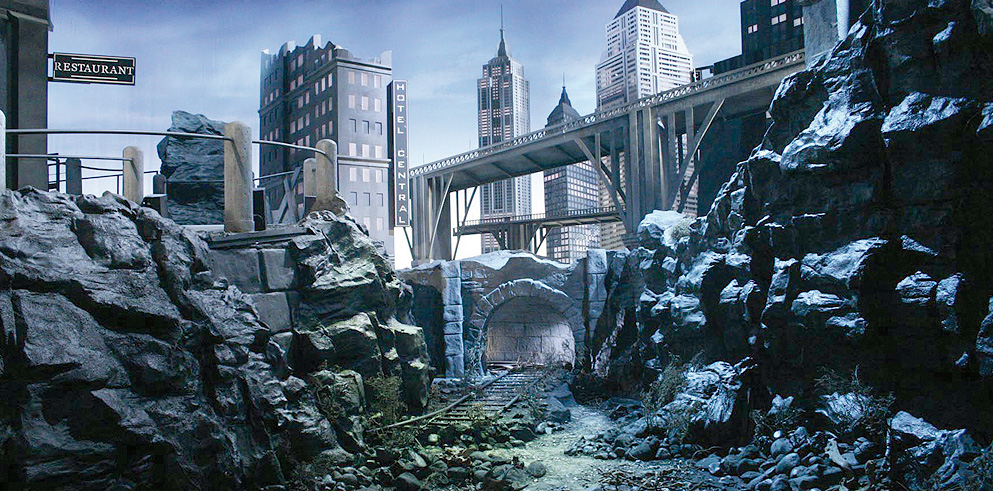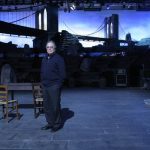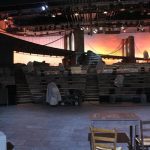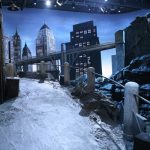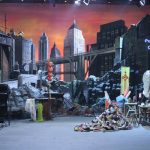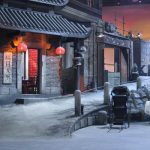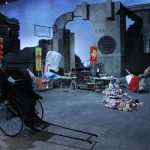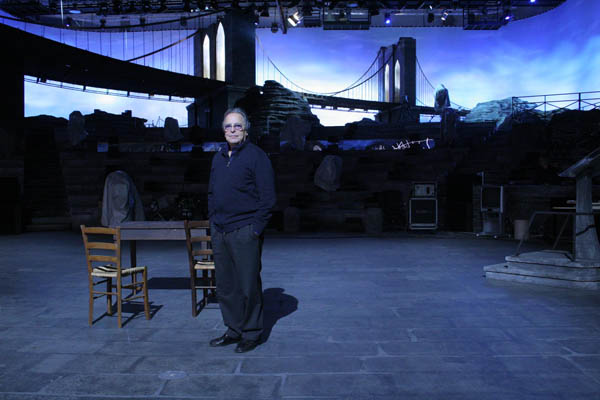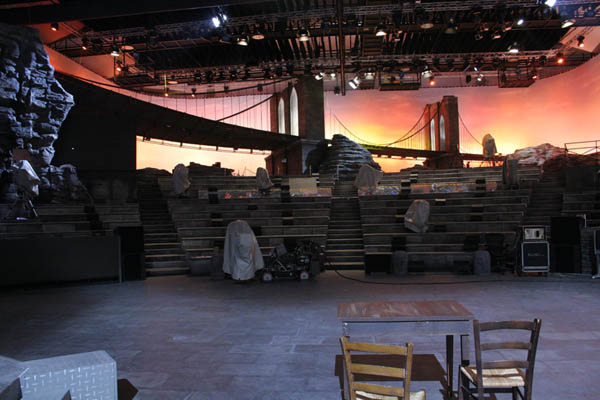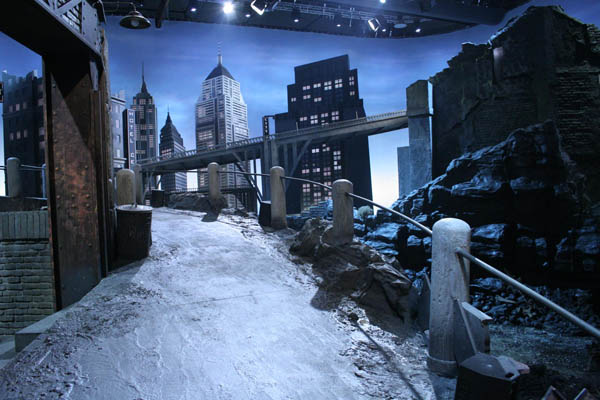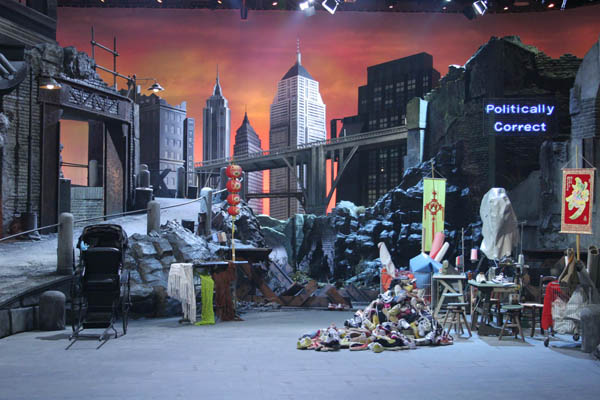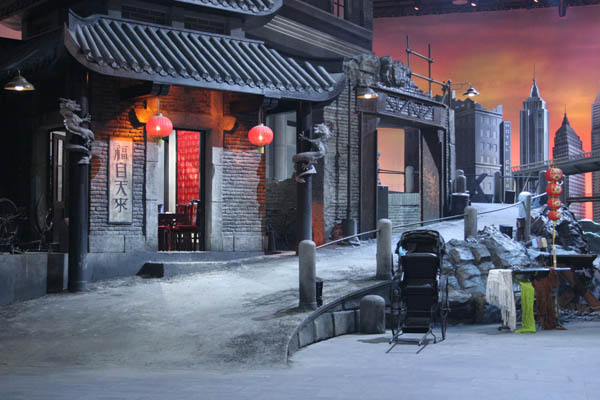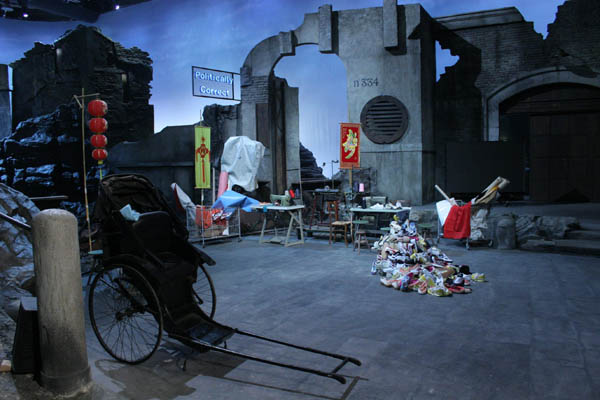The atmosphere of the event can always be sensed in all of Adriano Celentano’s TV appearances.This was also true in the case of RockPolitik, the TV programme written and directed by the “molleggiato” (Adriano Celentano’s nickname) and broadcast in a series of 4 live evening programmes on the RAI (Italian Broadcasting Corporation) channel in Autumn 2005.
RockPolitik had attracted the curiosity of the cultural world and of the media even before the programme was broadcast and the 4 evening programmes achieved peak audience ratings which were among the highest recorded in recent years, confirming that Celentano remains a cornerstone of our country’s Television system and culture.
But already in artistic terms, there was no fear of being disappointed: the ICEF television studios in Brugherio (MI) which hosted the transmission, were transformed into an enormous arena, filled with numerous three-dimensional stage settings made of fibreglass.The Brooklyn Bridge and the Manhattan skyscrapers, the Chinatown Pagoda, the remains of the ancient temples, sometimes almost full-scale, were placed side-by-side, as if to mean that the West embraces the East, the new civilisations joining with the old, in the name of a single great universal message: the communion of the people.All these stage settings are joined by rock, the pre-eminent natural element: the very galleries form a semi-amphitheatre positioned in a rock-like structure, sloping down towards the stage like an authentic event of classical ancient times.
From an analysis of the stage settings we can deduce that we are looking at a film show rather than a television show: the actors and the viewing public are immersed full-scale in a real set, where everyone becomes the centre of attention.Every division is removed, every detail of the structure is realistic and above all places the leading actors in a three-dimensional environment that not even a theatrical performance can achieve.
The contribution made by the lighting is fundamental, as well as synergetic to the development of the scene. The Director of Photography Franco Ferrari explains to us that a number of very important choices had to be made.The first choice was to construct the scene in black-and-white, assigning the lighting system the task of colouring the scene: this has made it possible to experience the same scene with different chromatic, artistic and emotional characteristics based on the various phases of the programme.
A second choice, linked to the first, was to use the backdrops above all as a chromatic union for the various stage setting elements.The backdrop is installed all along the arena’s perimeter, and is coloured to represent daylight, then twilight, then dawn, in a graduation of iridescent colours which we could not have achieved by using normal stage setting techniques.
“The absolute centre pieces of this operation were the CP Color MH lighting fixtures designed by Clay Paky” – explains Mr. Franco Ferrari. “These moving body colour wash solutions are very versatile, and provide maximum colour quality: accurate fading, very soft light dimmering, light beam angle of up to 80° without losing luminous intensity, a characteristic that has allowed me to illuminate the backdrops very uniformly even at close range.I installed 60 CP Color MH units all along the studio’s perimeter, no less than 260 linear metres, which enabled me to link all the narrative levels with a single colour shade”.
Another important role was played by the 48 Alpha Wash Halo, the halogen moving bodies designed by Clay Paky installed on the battens that overhang the entire studio area.“The Alpha Halogen units are used to highlight the stage setting and the points on the stage where the personalities move” – continues Mr. Ferrari. “Sometimes they are used to substitute the follow spots during the famous “monologues”, or with stationary guests.These projectors are essential for my work, because they combine high-quality colour mixing with a wide zoom, which makes it especially easy to light the scene.In addition, the Alpha Wash Halo – as fitted with a halogen lamp – provides the natural colour temperature of 3.200 K, and every professional is very familiar with the usefulness of this feature in a television context, where the light is filtered by the television camera’s digital eye”.
The lighting design is completed with a number of special effects projectors, used in given moments of the show to project naturalistic elements on the coloured backdrops, and with a few 2,500W rated PAR projectors to provide the environmental lighting.
Franco Ferrari’s style has always privileged the quality of light over the quantity of light.“Light is emotion, it must interpret the message and transfer that message to the public, conferring an added value.I used an essential number of light points for Rockpolitik, despite the studio’s width, but each lighting point has a precise use: each projector contributes to the construction of a chromatic language that is perfectly functional to the show.We could refer to it as “realistic lighting, considering the reality characteristics of this show and the nature of the stage settings”.The experience gained by Mr. Ferrari includes his role as Director of Photography for 20 editions of the Sanremo Festival, 3 editions of the Olympics, all of the previous shows performed by Celentano and a multitude of TV adaptations, events and television shows, ranging from ‘Canzonissima’ to the shows broadcast recently, during a career 35 years long.Mr. Franco Ferrari is currently lecturing in lighting technology and photometry, and works with a number of architectural firms, where he is introducing the professional lighting techniques to the architectural environment.
At a technological level, we must also mention that 2 ledwalls sized 8×4 metres were used in the RockPolitik show, which had a characteristic curved structure.The ledwalls act both as an attractive stage setting element for the backdrops, and as a functional tool to view films, particularly for the public in the studio.In fact, RockPolitik is a programme that is built brick after brick with apparent improvisation, where also the public present in the studio is a major player and participates in the life experienced in this “global village”.
Therefore, a great performance produced using great means: the RAI channel production together with Ballandi wanted to characterise RockPolitik as a real event, regardless of the programme’s cultural and social message.Very acclaimed by the public, RockPolitik can be seen – at least on a technical level – as the example of a new form of Television, which incorporates elements of the Cinema, the Theatre, Talk Shows, finally merging into a Variety Show, but using a language consisting of lights and shadows, silences, glances and emotional participation.
echnical Data Sheet
Production: RAI channel together with BALLANDI
Author and Director: Adriano Celentano
Director of Photography: Franco Ferrari
Art Director: Gaetano Castelli
Lighting Assistant: Riccardo De Poli
Console Operator: Massimiliano Fusco
Technical Manager: Piero Segesta
Dimmer operator: Benni Pellerito
Lighting by: Clay Paky
